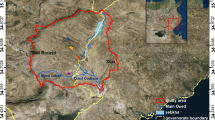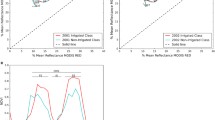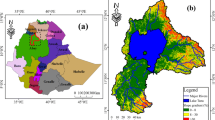Abstract
Much of the central-western region of Argentina, where San Juan Province is located, experiences arid to semi-arid climatic conditions with low average annual rainfall accompanied by substantial evapotranspiration. Consequently, a viable crop industry depends to a large extent upon irrigation from major river systems. Increasing demand for water in the lower basin of the San Juan River is emphasizing the need for more accurate estimates of water used for irrigation. Since the water demand for a particular crop is very closely related to crop area, monitoring the area of crop under irrigation is considered a proxy for the amount of water used. Landsat 5 imagery for the growing season, field data and aerial photographs were used to evaluate crop area.
Similar content being viewed by others
Avoid common mistakes on your manuscript.
Introduction
New developments in remote sensing, geographical information systems (GIS) and modeling have provided water resource researchers and managers with many interesting tools to use to obtain accurate spatial data on actual water use, water demand, allocation and productivity.
In arid and semiarid environments, the development of regions economically dependent on agricultural activities may cause an irrational use of water and natural resources with resulting environmental degradation. In such a case, space technology makes available the information needed by government organizations for the sustainable management of resources. Real-time information on natural resources is a crucial requirement for the sustainable development of arid regions. It is thus sensible to devise an integrated scheme which may put these limited resources to the best use possible, as well as to set appropriate policies and regulations for land use.
In recent years, the availability of trained technicians qualified in this field has helped to introduce these novel technologies and labor practices for a faster, more rational regional development, carrying out research projects on the estimation of farmed areas and the processes of soil salinization. Integration of research institutions, government officers and private companies, helps to optimize the formation of regional human resources, as well as the dissemination of gathered information oriented to different community levels.
The use of satellite images has a direct impact on management of potable water, hydroelectric resources, and on civil defense and other economic activities such as agriculture.
As much of the central-western region of Argentina, where the study area is located, experiences arid to semi-arid climatic conditions with low average annual rainfalls accompanied by substantial evapotranspiration, a viable crop industry depends to a large extent upon irrigation from major river system. The San Juan River itself receives major inflows from seasonal snows in the Andes Mountains, and in dry years can run at very low levels or stop flowing altogether, leading to increase the salinization of the water supplies of the cities downstream. Consequently, additional demands on the river made by irrigation must be carefully controlled. In San Juan Province such control is exercised by issue of irrigation licenses to farmers. It is then necessary to monitor their usage of water to ensure licenses are not infringed. This, of course, is the situation in many parts of the world were extensive irrigation systems are in use.
Materials and methods
The study region
The study area, the Tulum Valley, is located in the region called Cuyo in central-western Argentina (Fig. 1). The lower basin of the San Juan River, where it flows through the valleys of Ullum-Zonda and Tulum, is one of the larger known, intensively farmed valleys (approximately 100,000 ha), crossed by an intricate artificial irrigation network formed by channels totalling more than 1,000 km in length (Fig. 2). This area contains the most important economic activity in the whole province, which is the cultivation of grapevine. The capital city, San Juan, is located here, and 90% of the social, economic and cultural activity of the province takes place there.
The Cuyo region is characterized by a scarce, irregular rain pattern. The annual rainfall is very low (∼100 mm). Precipitation is more frequent in summer time, mainly in January, concurrent with the peak of snowmelt flow of Andean rivers. A typical aspect of these arid, mountainous regions is the occurrence of cyclical drought and flood periods. Under these circumstances, the fertile valleys have been intensively farmed, with an intricate irrigation network. In the last decade, new areas have been incorporated with automatic pipe-irrigation and dripping systems. Therefore, rapid changes have been experienced in the cultivated region from these practices. The natural region, which is covered by sparse forest and shrubs, changes very little with the seasons.
Both wild and man-occupied spaces may be adversely affected by irrational land-use practices or lack of environmental protection and recovery plans. Particularly, the Cuyo region has long been experiencing a degradation of cultivated soils due to salinity, a problem having few solutions at present. The economic activities in these areas are mainly based in agriculture production, with olive oil and wine as the most important products, and are strongly dependent on the behavior of water supply systems.
The soils have a poor development of the edaphogenic horizons. The phyto-geographical “Mountain Province” covers the entire zone under study (Cabrera 1994) and is generally characterized by shrub steppes where xerophytes and halophyte species prevail. Small forest areas and marshy environments associated with local conditions are also found. The main crop is grapevine (51%), and annual crops of vegetables (11%).
All the water available for agriculture is supplied through irrigation, the main source of water, more than 80% of the total, being the San Juan River. Irrigation practices are mainly superficial irrigation over the soil surface and along ruts (85%) and a small amount via pressurized irrigation: drip and micro-aspersion. Another characteristic is the prevalence of small agricultural establishments. According to statistics, the majority are approximately 10 ha. The garlic and onion producers work with less than 2 ha.
Data
Landsat TM 5 imagery, path/row 232/82, was used in this study, in order to map land use and irrigated crop areas during the 1998–1999 and 1999–2000 growing seasons (Table 1). The dates for the images were selected considering the phenologic cycle of the principal crops in the study area. Ground reference data samples were collected from each crop in the area.
At present, Landsat TM imagery is available at a low cost due to the fact that Argentina has a receiving ground station at Falda del Carmen, Córdoba, which belongs to CONAE (National Commission for Space Activities).
Methodology
The water demand of a particular crop is very closely related to crop area, because most water taken up by plants is used in transpiration. Consequently, the determination and monitoring of the crop areas under irrigation is a necessary step to evaluate the irrigation water demand.
Assessment of cultivated areas through multitemporal satellite information
In this study, Landsat multispectral image data for different seasons, field samples and classification techniques are used to provide crop area estimates, through the direct counting of pixels from classified images. Direct counting of pixels is an automatic method for surface area assessment (Gonzalez-Alonzo 1997), from which the surface area of each of the categories identified by the classifier is calculated.
The classification techniques may have limitations due to the similitude in spectral response among the various classes of the classified scene. When these similitudes do exist and an area occupied by a determined class in the classified image does not exactly correspond to a determined category of land cover or land use, spectral enhancements are used to emphasize the differences among classes.
When dealing with complex agriculture systems, like the one under study in the valley of Tulum, the analysis of data from remote sensors obtained for a single date does not allow the precise discrimination of areas occupied by the crops of interest. As concluded from previous work (Salinas de Salmuni et al. 1997), crop discrimination using multi-spectral classification for only one date proved to be inefficient, due to the great heterogeneity of crops, mainly caused by a large amount of small orchards. In later studies better accuracy was achieved, but only in very homogeneous zones, like the Department of Caucete, where grapevines represent more than 90% of total crops.
Therefore, when the dynamics of land use and cover shows a high temporal variability, many authors recognize the advantage of using multi-temporal data for mapping purposes (Ippoliti 1998). Pilion et al. (1988) designed a multicomponent approach using Landsat MSS images from various dates in order to detect changes in the cover and use of agricultural soil in semi-arid zones in a region of N.E. Nigeria, and demonstrated that this method was able to provide comprehensive information about location, extension and nature of man-made changes. Hill and Sturn (1991) stated that images provided by a single satellite pass are not enough to obtain good, accurate classifications for the majority of agricultural situations, mainly due to the spectral ambiguity which can be found in the different phenologic stages of crops. Also, Lillesand and Kiefer (1994) noted that observations, through images of various dates, of spatial and spectral changes occurring during the growing of crops, allowed discrimination to be made that would not be possible from single date image data. Consequently, phenologic cycles indicate the time of the year when remote sensing data have to be collected, in order to obtain the best information about changes.
The cycle of grapevines is shown schematically in Fig. 3. It begins in September, with a gradual increase of vegetation cover caused by the growing of leaves, reaching a complete cover at the end of November. This cover remains until March and diminishes significantly in April, followed by the total loss of leaves in May. For onion and garlic, two cycles can be distinguished, an early and a late one. The overlapping of both cycles covers a period which begins in May and ends in December. The initial period of this cycle is characterized by very low vegetation cover which makes its detection from satellite remote sensing very difficult. For this reason, it was necessary to accomplish a very rigorous calibration of the images and also to apply an enhancement procedure that makes its detection possible. The olive tree, which is the second most important crop in the zone, has a continuous cycle. These trees are separated by about 8 meters between them and so the soil component becomes important in the satellite sensor register. In winter, the soil has no vegetation cover. Therefore, in these months the sensor registers less vegetation. In Fig. 3 this phenomenon causes a sort of slimming of the sky-blue band, from May to September.
Taking into account the preceding considerations, the dates were selected according to the following detail:
-
One winter date, adequate to detect early onion and garlic and olive. In these months, grapevines remain without leaves.
-
One spring date, to detect late onion and garlic. Grapevines exhibit cover and olive trees remain the same.
-
One summer date, which is mainly used to detect grapevines, while olives remain perennial.
In Fig. 4 these three images are shown for the Department of Caucete. There, the darkest grey tones correspond to the poorest vegetation cover (winter). On the other hand, lighter grey tones indicate high vegetation cover, for summer time.
Use of spectral enhancement: Vegetation Index
Enhancement procedures are accomplished on an image in order to make it more interpretable for a given application. Since healthy vegetation exhibits high values for the near infrared (Band 4) and low values in the red within visible range (Band 3), one of the most widely used transformations for crop discrimination is the Normal Vegetation Index (NDVI), defined by NDVI = (B4 − B3) × (B4 + B3)−1, where B3 and B4 are spectral Bands 3 and 4. Bare soil reflects in a similar way in both bands, and so, the greater the contrast between Band 4 and Band 3, the greater will be the vigor of vegetation cover. The resulting NDVI image exhibits high values where healthy vegetation occurs and lower values where vegetation is scarce or less vigorous. Intermediate values can give an idea of the type of crop or natural vegetation to be found in the image.
Application of the change detection method by RGB combination of multitemporal enhanced images
Basically, the technique consists in the combination of three bands, red, green and blue (RGB), to obtain a multi-temporal colored composition. The resulting colors are the product of the combination of RGB colors corresponding to each date. In the colored image pixels without change show grey tones, while those which experienced changes appear in colors, with predominance of one of the three for the biggest change between dates.
This change detection method, takes advantage of the spectral information from the three more important dates of the phenologic cycle of the main crops in the valley. Thus, a multi-band image was formed, where each one of the three bands is the NDVI for each date. Estimates of cultivated areas for the phenologic cycle 1998–1999, were obtained by multi-temporal unsupervised classification (Fig. 5).
For crop discrimination, the ISODATA algorithm was applied. In this particular case, various classifications with 10, 15, 20, 25 and 30 classes over the NDVI multitemporal image were tried. The 30-classes classification was selected, since it allowed the separation between olive tree and grapevine with organic fertilizers. These two covers are often confused between each other, because the organic fertilizer consists of winter crops located between the grapevine rows, and the satellite sensor registers them with high NDVI values.
In the thematic map thus generated, olive and grapevine crops (in lighter grey tones) are clearly distinguished from the rest of the covers (Fig. 5). Even when there is a simultaneous occurrence of summer and winter crops, these later cover very small areas (<2 ha), therefore they were not separated.
Accuracy of the estimation
The estimation of the accuracy of both the classification process and the thematic map were made by means of confusion matrix analysis (Congalton et al. 1999). In doing this, not only the verification samples obtained in fieldwork of January 1999 were used, but also some data collected from aerial pictures.
Three classes are listed in Table 2: (1) grapevines; (2) olive trees and (3) of no interest. This latter class comprises land covers that show no change (natural vegetation, bare soil, salinizated soil and new crops). The estimate of accuracy has been calculated and gives an overall precision of approximately 85% for the crops considered: grapevine and olive.
Results analysis
-
1.
There are several means by which irrigated crop area inventories can be performed. One of them is to make use of image data of some sort. Imagery from remote sensing satellites is particularly suitable for making area inventories, owing to its timeliness and to its relatively low cost.
-
2.
Fields under irrigation can be clearly distinguished by their shape, as well as by their spectral properties.
-
3.
By considering several other land cover types as separate information classes instead of a common “no irrigated” class, other geometric features of interest become evident. For example, the San Juan River is easily seen, as are some neighboring fields that are not irrigated.
-
4.
The results of the classification agreed remarkably well with ground-based data gathered by fieldwork.
-
5.
The main advantages of the use of satellite data are:
-
Low cost of the study.
-
Objective discrimination.
-
Zonification of the agro-ecosystem.
-
Assessment of the accuracy in crop classification.
-
Monitoring of agricultural land use.
-
Conclusions
-
1.
The water demand of a particular crop is very closely related to crop area, because most water taken up by plants is used in transpiration. As a result, it is sufficient to monitor the crop area under irrigation as an indication of the amount of water used.
-
2.
An irrigated crop inventory using satellite imagery classification has been shown to be more cost effective than photo-interpretation or ground studies. The processing method presented here is easily undertaken, with low computing cost and high potential for studies in semi-arid regions.
-
3.
Generally speaking, the combined classification strategy adopted here can be easily used as a way to identify a reliable set of spectral classes upon which a classification can be based.
References
Cabrera, A. L. (1994). Regiones Fitogeográficas Argentinas. In Enciclopedia de Agricultura y Jardinería, II, Fascículo 1. Acme, Buenos Aires.
Congalton, R. G., & Green, K., (1999). Assessing the accuracy of remotely sensed data: Principles and practice. Mapping Sciences Series, New York: CRC Press Inc.
Gonzalez-Alonzo Cuevas, J. M. (1997). Remote sensing and agricultural statistics: Crop area estimation in north-eastern Spain through diachronic Landsat T and ground sample data. International Journal of Remote Sensing, 18(2), 467–470.
Hill, J., & Sturn, B., (1991). Radiometric correction of multitemporal Thematic Mapper data for use in agricultural land-cover classification and vegetation monitoring. International Journal of Remote Sensing, 12(7), 1471–1491.
Ippoliti, R. (1998). Imagens TM/Landsat 5 da época de pré-plantío para a previsao da área de culturas de verão. Dissertacao de maestrado em Sensoriamento Remoto. Dissertation, CEP, INPE-7116-TDI/668, Brazil.
Lillesand, T. M., & Kiefer, R. W., (1994). Remote sensing and image interpretation (3rd ed.). New York: John Wiley and Sons Inc.
Pilon, P. G., Howarth, P. J., & Bullock, R. A., (1988). An enhanced classification approach to change detection in semi-arid environments. Photogrametric engineering and Remote Sensing, 54(12), 1709–1716.
Salinas de Salmuni, G., Maldonado, F., Ibañez, G. & Kulichevschi, L. (1997). Discriminación de cultivos de vid y estimación de áreas mediante Procesamiento Digital de Imágenes Satelitarias. [CD-ROM]. Paper presented at the VII Simposio de Especialistas Latinoamericanos de Percepción Remota y S.I.G., “SELPER”, Mérida, Venezuela.
Author information
Authors and Affiliations
Corresponding author
Rights and permissions
About this article
Cite this article
de Salmuni, G.S., Velasco, I., Fresina, M. et al. Irrigated area determination: a case study in the Province of San Juan, Argentina. GeoJournal 70, 273–279 (2007). https://doi.org/10.1007/s10708-008-9141-0
Published:
Issue Date:
DOI: https://doi.org/10.1007/s10708-008-9141-0









